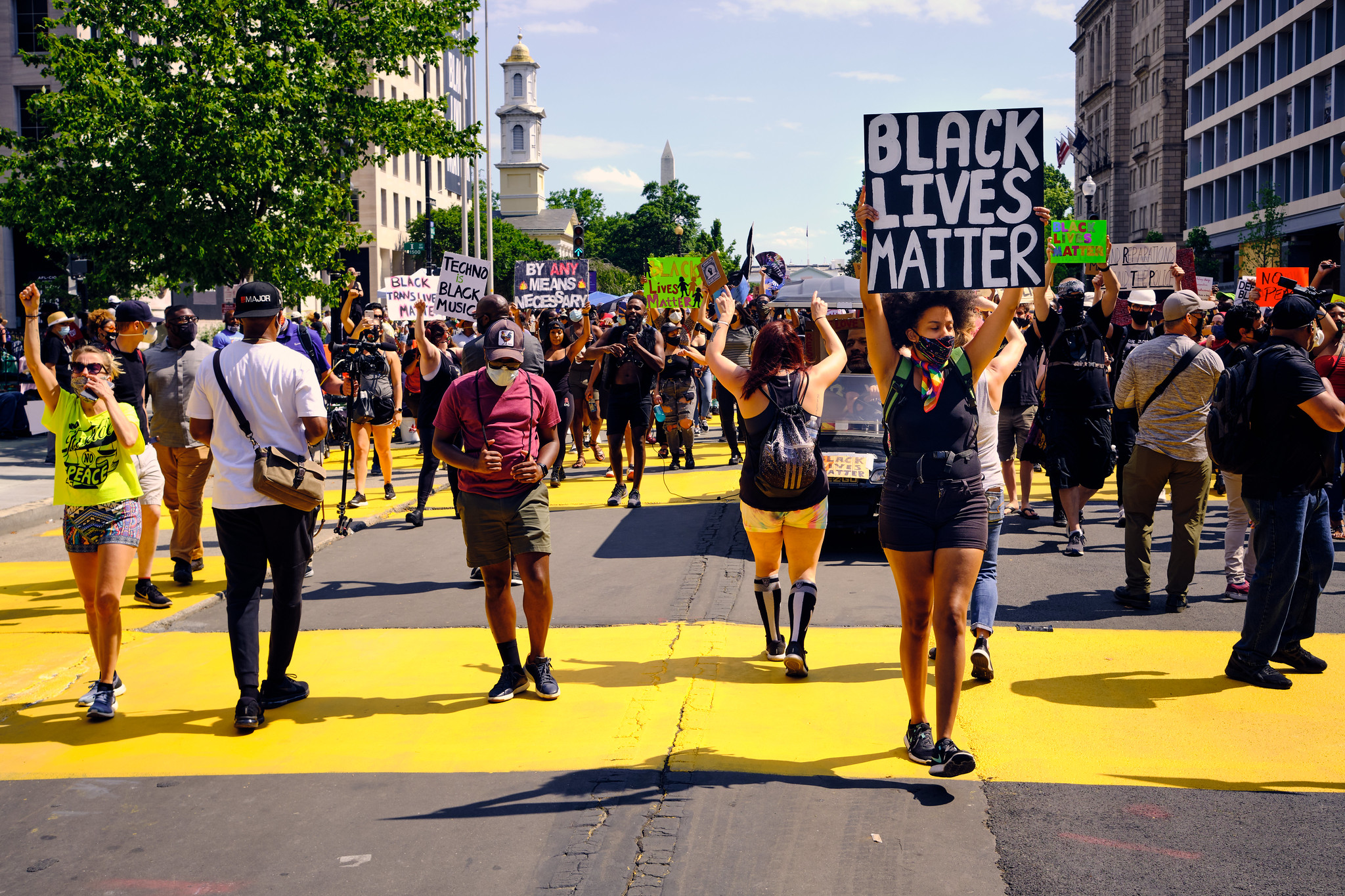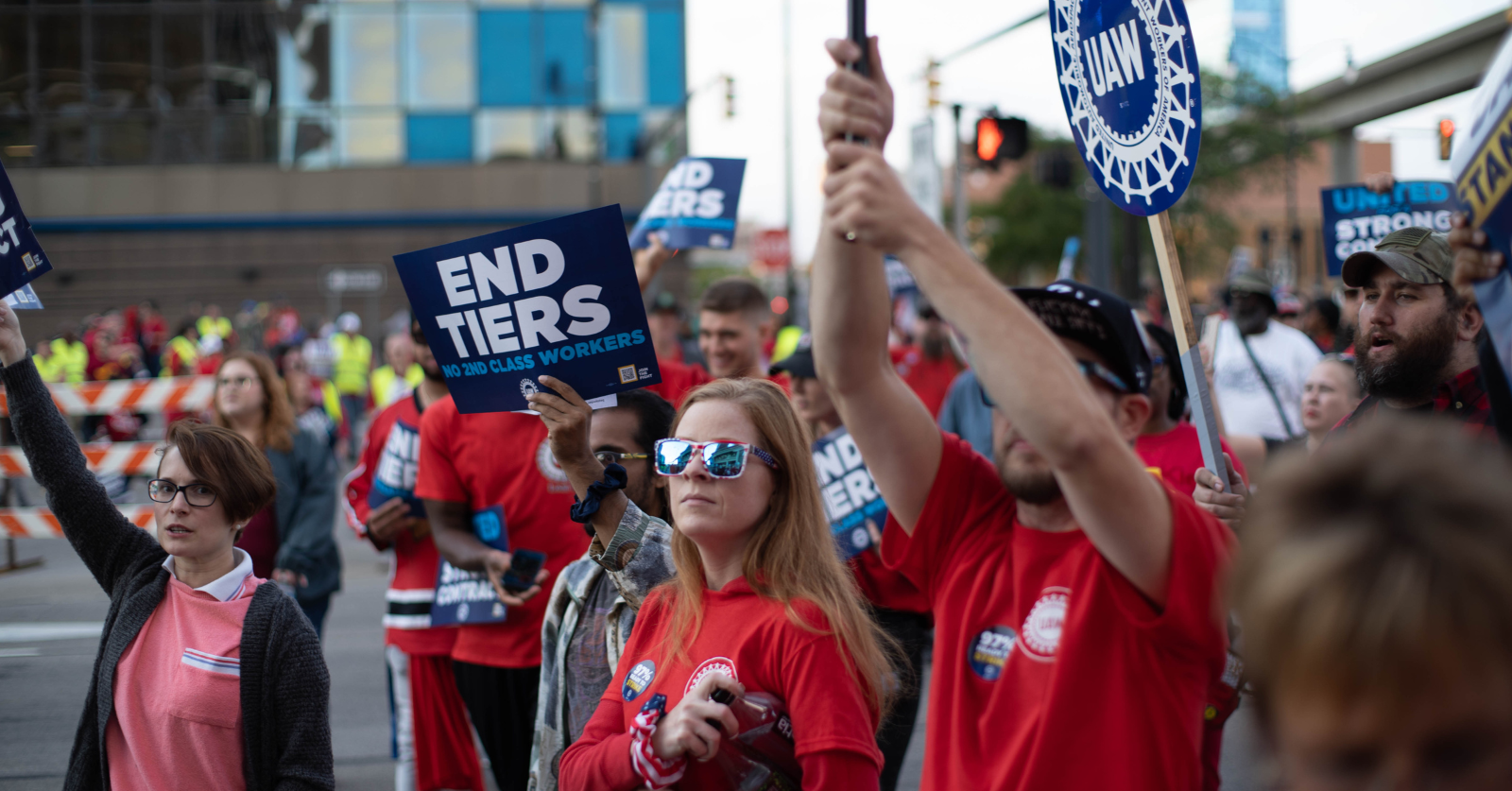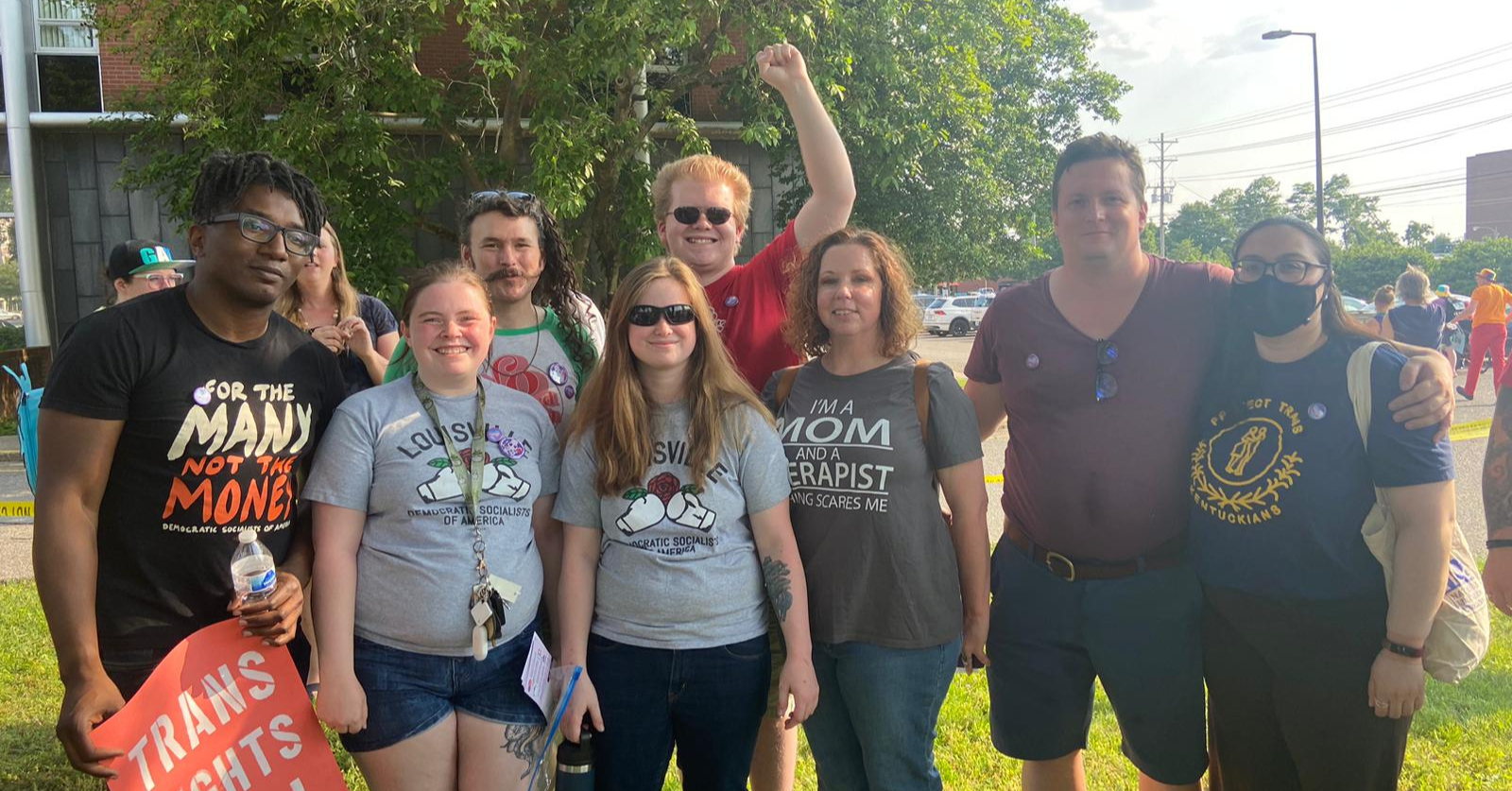If you like this piece, read more about where we stand and sign up to get our occasional email bulletins!
We’d like to begin by thanking R.L. Stephens for engaging with our piece in a productive and comradely fashion. He’s right to stress that our movement’s ability to have a fruitful democratic debate about strategy requires avoiding callouts and personal attacks. In that same spirit of discussion, we think it’s necessary to respond to the important points raised by Stephens’s contribution and to articulate a case for the centrality of class politics.
In our view, Stephens’ response has two major shortcomings. First, much of his piece consists of disproving arguments that we didn’t actually make. Second, and more substantively, Stephens rejects the need to focus socialist strategy on cohering the working class — i.e. wage earners and their families — as an independent and united force against capitalism. Because he does not propose an alternative perspective on where and what to politically prioritize, Stephens doesn’t put forward any clear strategy at all. Instead, he presents a socialist justification for the Left’s prevailing “movement of movements” approach, which has failed to provide a coherent political alternative to neoliberal capitalism.
Unfortunately, Stephens’s response largely presents a straw man of our case, against which he proposes his own alternative analysis. Specifically, Stephens implies that we “reduce … class to the workplace or even the wage” and that we separate the “political” and “economic.” On the contrary, we argued that the workplace is hardly the only site of class struggle. Leaning on Briahna Gray’s recent piece, we emphasized the importance of mass campaigns like the Medicare for All movement. We also showed that socialist electoral efforts like those of Bernie Sanders, Alexandria Ocasio-Cortez, and Jovanka Beckles are examples of independent class struggle — a form of politics that, as we insisted, includes raising “specific demands like abolishing ICE or ending cash bail.” In fact, we explicitly argued that fights against racial oppression are “part of, not in conflict with, the process of building a socialist movement.”
Similarly, we showed that class struggle is always necessarily political — i.e. a challenge against the state — and never purely “economic.” Virtually all of the examples we cited as positive instances of class struggle were simultaneously economic and political: the educators’ strikes, the fight for Medicare for All, and socialist electoral campaigns. The only cited example of class struggle that did not directly challenge the state was the wildcat strike of UPS workers against a racist boss, which we highlighted precisely to show the power of workers to directly combat racism.
That said, Stephens is correct that there are major differences between our respective political approaches. We believe that our primary disagreement is over how central the working class should be to socialist strategy.
The Centrality of Class
Advocating for class centrality means that we place exploitation at the center of our analysis of capitalism and uniting workers as a class at the heart of our strategy for achieving democratic socialism.
The working class fundamentally consists of all those individuals and their families whose survival ultimately depends on wage labor. Capitalists dominate society on the basis of the exploitation of these wage workers, who produce capitalists’ profit. By the same token, this makes the employer class dependent on the cooperation (willing or otherwise) of working people. As the editors of The Call write this relationship “endows us with the potential power to stop production and overturn the political system. Ending capitalism will require mobilizing this immense power, and this puts the question of organizing the working class as workers at the center of questions of strategy.”
Stephens puts forward a very different analysis of capitalism and therefore a very different political perspective. He draws on the arguments of two thinkers, Harry Cleaver and Maria Mies, both of whom explicitly reject the analysis and strategy we laid out above. Both tell the same story about the supposedly fatal limitations of the socialist movement; they claim that the experiences of the 1960s new social movements and anti-colonial rebellions demonstrate the inadequacy of the traditional Marxist conception which places the working class at the center of anti-capitalist struggle.
Stephens approvingly cites Cleaver’s insistence that the New Left correctly understood the inadequacies of orthodox Marxism, which failed to recognize the political centrality of the struggles of the unwaged: specifically, peasant, student, and women’s revolts. Though Cleaver openly agrees with the New Left’s political stance on this question, he questions its theoretical approach because it “accepted [Marxist] orthodoxy’s exclusion of these groups from the working class” (pg. 43–44). Thus, for Cleaver and Stephens, the working class must be understood far more broadly than Marxists had hitherto conceived, in order to articulate a new socialist perspective not centered around wage workers.
Stephens likewise praises Maria Mies’ “Patriarchy and Accumulation on a World Scale,” which makes a similar analytical and political argument. Her main point is that since Marx and Engels analytically “exclude or drop … the production of new people” through women’s unwaged household labor, therefore “within Marxist theory a historical materialist conception of women and their labour is not possible” (page 51). Instead of the waged working class, Mies concludes that the real revolutionary subject is an alliance of “women in the overdeveloped classes and countries … combined with a production liberation movement in underdeveloped countries and classes” whose “first step” politically “could be a consumer liberation movement” (page 5).
We disagree with the analysis put forth by Stephens via Cleaver and Mies, as well as with its related political conclusions. Our own understanding of the relationship between women’s oppression and capitalism leans on Lise Vogel’s 1983 work “Marxism and the Oppression of Women.” In it, Vogel demonstrates that “class struggle over conditions of production represents the central dynamic of social development in societies characterized by exploitation.” In contrast to women from the propertied class, the oppression of working-class women, she argues, derives from their “involvement in processes that renew direct producers [i.e. household labor to raise the future generation of wage earners], as well as their involvement in production [i.e. wage labor]” (page 129).
Some fundamental insights about what makes the working class — made up of people of all races, genders, sexual orientations, etc. — structurally different from other subordinate social groups flow from this conception of class and exploitation:
- The interests of the whole working class and the capitalist class are diametrically opposed. In contrast, most other subordinate groups — women, people of color, queer people, etc. — include people within the capitalist class as well as people in the working class.
- The stratifications and divisions within the working class — including by race, gender, national origin — are fundamentally different than the inherent antagonism between workers and employers caused by wage exploitation. Working-class unity is structurally possible, though far from inevitable.
- The workplace is the primary, but not exclusive, strategic site of class struggle because it is where working people have the most potential power.
Given Stephens’s acceptance of Cleaver and Mies’s analysis of capitalism and class, it’s understandable that he rejects this final political point. What’s more surprising is that Stephens invokes Lenin and Rosa Luxemburg to bolster his case, given that both of these thinkers and their respective political currents consistently advocated for the centrality of class and focused the vast majority of their efforts on organizing wage earners at the point of production. As Luxemburg put it, “Where the chains of capitalism are forged, there must the chains be broken.”
Stephens separates social class from its basis in workplace exploitation and divorces socialist strategy from a focus on cohering wage workers as an independently organized force against their exploiters. But what is his political alternative? If Stephens rejects prioritizing class-wide demands that politicize and mobilize the largest number of workers against their class enemies, what’s his proposed criteria for an alternative approach? And where does Stephens think the most strategically central site(s) of class struggle lie if not the workplace? Unfortunately, he does not provide any answers to these crucial questions.
If every struggle and demand of the oppressed was an equally compelling place for socialists to focus our energies, then there would be no need for political prioritization and therefore no need for strategy. But, in practice, time and resources are finite. The prevailing “movement of movements” approach on the Left — which treats organized labor as, at best, just one good movement among a dozen others — basically elides this key question.
Fortunately, the 2016 Bernie Sanders campaign and the first strike wave in 40 years have prompted many leftists to start reconsidering how and where we can concentrate and build our forces in the most effective manner possible. In the following sections, we’ll show what a class-centered strategy means today for a) what kind of demands we should emphasize and b) where we should focus our organizing efforts.
Class-Wide Demands
To generate power, we need to mobilize and organize the widest layer of workers possible. And, as every organizer quickly learns, it’s generally much easier to organize people around those issues that they already feel strongly about and that they perceive to directly affect them. These two insights should serve as the starting point when we consider what demands to focus on at a given time and place.
In general, socialists can be most effective by emphasizing struggles around class-wide demands, i.e. policies directly benefiting all or most of the working class (in a given area or industry) at the expense of the capitalist class. Class-wide demands best reveal the conflict inherent in capitalism between the exploited majority and the exploiting minority, while cohering the disparate and diverse layers of working people together into common class organizations. In other words, such demands help to advance the working class as an independent political subject. That’s why both Sanders and Ocasio-Cortez consistently foreground broad issues like Medicare for All and why the recent teachers’ strikes focused on better pay, which would benefit all education workers, and school funding, which would benefit their state’s working-class majority.
If implemented, these demands would begin to undo the material basis of racial (and gender) inequality in our society, making them essential to any program to fight racial injustice. That these would indeed also combat the causes of racism (an argument which Stephens claims is “a bridge too far”) has already been argued by Robert Greene II, who suggests that the Left should prioritize the fight for universal healthcare to help undermine support among working-class whites for far-right politics. In our first piece, we noted that civil rights leaders like King and Randolph argued that the movement should fight for redistributive reforms to undermine the “fearful competition for scarce resources” between workers, eliminate “one of the material bases of racism” and strengthen a “sense of interracial solidarity.”
Finally, because these programs would not only expand the political consciousness and organizational capacities of the working class, but also shift power and resources from capital to workers, once achieved they can pave the way for more radical demands in the future.
This doesn’t mean that we should only fight for class-wide issues. It’s often important to fight for demands that only directly benefit smaller sections of the working class — an end to deportations, for example. And it’s analytically useful to distinguish between these two types of demands, even if winning policies like an end to deportations would indirectly benefit the whole working class.
Class-wide demands are necessary but insufficient because they can’t on their own end the inequalities that exist within the working class and society at large. Furthermore, at given moments or even extended periods (e.g. the Civil Rights movement), struggles against the domination of oppressed minorities can become central to political life. In our first piece, we pointed to how recent struggles for immigrants rights and against police murders of Black people have radicalized millions of people, many of whom can be won to socialist politics. Socialists should generally try to find ways to participate in these types of struggles — particularly when they have the potential to mobilize large numbers of people — and to help push them in the direction of independent mass action.
Of course, it’s not always easy in practice to find the most effective way to center class-wide demands while also supporting fights against more particular instances of oppression. Every organization, no matter its political persuasion, necessarily has to choose where to focus; no organization can effectively fight for every progressive demand or participate in every social struggle at every moment. The art of politics consists of developing a concrete analysis of a concrete situation in order to make a wager on how and where we can mostly effectively push the class struggle forward.
Unfortunately, most Left discussions on identity and class remain pitched at an overly high level of abstraction. Consequently, they fail to address the nitty-gritty of how to organize in particular cities, industries, or movements at a specific moment in time. Effective tactics, however, are always context-specific. For example, in the Chicago teachers’ strike of 2012, union organizers judged that it was absolutely necessary to consistently raise racial justice demands. By contrast, the recent strike in West Virginia won without doing so.
There’s no simple formula for success. Often, socialists bend the stick too far in one direction or the other. But without a strategy based on class centrality, the Left will keep bending to the prevailing political winds. Class remains the great taboo in mainstream U.S. political life. The Democratic Party and the panoply of liberal NGOs can talk about fighting racism, sexism, and environmental degradation — though they do so in ways that never challenge oppression and climate change at their roots — but they remain conspicuously silent when it comes to fighting class exploitation.
Well-funded NGOs promote all sorts of positive social demands that do little to cohere workers as a united and independent force or to challenge capitalists’ political and economic interests. And though it’s true that racism and sexism have their worst impact on working-class people, it’s also the case that most non-workplace movements against oppression are generally cross-class in nature. To build a movement that can tackle these oppressions at their root, socialists have to polarize society along class lines by demonstrating the shared interests of the whole working class and work toward building independent class organizations.
Focus on the Workplace
An effective socialist strategy requires that we not only mobilize and organize the widest layer of workers possible but that we do so in structural locations that can best leverage their social power. In other words, where we focus our efforts is no less strategically important than what demands we focus on winning.
The new social movements praised by Cleaver and Mies have scored many important victories, but none have approximated the social weight of organized labor at its height. Without the existence of a strong labor movement capable of challenging capital and the state, organized radicals have remained relatively marginal — and movements against oppression and environmental devastation have been unable to generate the social strength necessary to extract their most far-reaching demands.
That’s why we need to prioritize building power at the workplace, the place in society where workers can potentially exert their greatest leverage. In the latest issue of Democratic Left, Joe Burns notes that “the red state rebellion of teachers has once again demonstrated the incredible power of collective action. Ignoring legal restrictions on their right to strike, tens of thousands of teachers in so-called red states struck anyway, forcing reactionary politicians to the bargaining table.” While many other essential tactics have been employed by working-class movements, “none can substitute for the power of a production-stopping strike based on solidarity.” This holds true in the public sector, even though its employees don’t directly produce profits. By shutting down essential services necessary for conducting everyday life (schools, transportation, etc.), public employees can win their demands through creating a deep social crisis while winning broad public support.
Acknowledging that strikes are our most powerful weapon doesn’t require socialists to ignore oppression. For starters, racial and gender domination are reproduced in the workplace through wage differentials, the exclusion of people of color and women from certain jobs, sexual and racial harassment at work, and the absence of sufficient employer-provided childcare and eldercare (reproductive activities that working-class women are expected to undertake without compensation). We have a particular power at work to effectively fight around these burning issues. Without challenging and overcoming these internal divisions, it will not be possible to build a truly unified working-class movement.
Building unity is definitely easier said than done. Given the fracturing pressures of capitalist competition, and the constant attempts by reactionaries, capitalists, and their NGO, liberal, and academic apologists to divide working people, socialists must go out of our way to make it clear that we support the interests and demands of all working people, not just its relatively advantaged layers.
Labor organizing can also serve as the social base for demands outside the workplace. Boots Riley, in his recent interview on “Democracy Now!,” argues that “campaigns against police brutality may become more effective once other parts of our movement also grow and where … we have some leverage.” Noting that the Left and social movements are “not putting out a clear analysis of how power works,” Riley specifically pointed to the potential for labor strikes to force the state to indict killer cops. Indeed, there are many precedents for mass strikes on behalf of particularly oppressed sectors of the populations. In 2006, for example, millions of undocumented workers and their supporters took off work in a de facto general strike that effectively forced the Republicans to drop their reactionary anti-immigrant bill.
Our point is not that the workplace is the only site of class struggle. While strong workplace organization is necessary for building an effective socialist movement, it is by no means sufficient. Very often, the level of trade union organization is too weak, or the policy of the union leadership too timid, for working people and all the oppressed to see the labor movement as a viable vehicle to express their demands. Mass marches and civil disobedience are frequently the best that our side can do at a given moment. Thus while we should prioritize rebuilding a militant workers’ movement that can serve as tribune for all the oppressed, it would be deeply misguided to abstain from all social movement struggles outside the workplace — for example, mass demonstrations against family separations or for reproductive justice.
Past experience bears out how shop-floor militancy can become the central political lever of a much broader social upsurge. For instance, bread riots, mostly led by women, played a central role in catalyzing the French and Russian Revolutions. The same was true in the recent Arab Spring uprisings. But, like Russia in February 1917, these riots erupted in a context marked by rising labor militancy and it was only once the movements in Egypt and, particularly, Tunisia culminated in mass strikes that working people were able to topple the hated regimes.
While the “movement of movements” approach takes the current hegemony of non-workplace organizing as a positive development, our perspective aims to shift the struggle toward the arena and organizations where the working-class majority has the most potential power. The perspective articulated by Stephens, Mies, and Cleaver, however, entails a strategic adaptation to the prevailing disunity and weakness of the working-class movement, rather than a perspective capable of overcoming these limitations.
A final point: In capitalist democracies like the U.S., electoral battles will likely continue to be the single most important site of class struggle outside the workplace. Whether we like it or not, most people’s only source of engagement with politics is the electoral arena. As such, if we want to build a mass working-class movement of millions, we cannot afford to underestimate the political importance of election campaigns.
Neal Meyer and Ben B. put it well in their recent article “The Case for Bernie 2020.”
“The best electoral hope we have right now to raise the class consciousness of millions of people is once more through a Bernie Sanders presidential campaign. His platform of ending austerity, passing Medicare for All, raising the minimum wage, expanding Social Security, and making public colleges tuition free will speak to the needs of working-class people. His plans to tackle mass incarceration, end cash bail, protect immigrants regardless of their status, and combat climate change speak to and help frame the growing movements to end state repression and the trashing of the environment…
“What matters in a period like ours, when we can’t reasonably expect the socialist movement to take state power, is moving people from resignation into action around the issues they care about right now. In the process, we need to raise awareness that even winning immediate demands like Medicare for All will take a confrontation with the capitalist class. When millions share that common understanding, then opportunities for deeper and more radical challenges to the system will become possible — particularly if there is a strong socialist left contesting elections and organizing in unions and mass movements.”
We believe that the best path forward for socialists is to put class at the center of our strategy. Properly understood, this approach includes raising demands and supporting concrete struggles that address the specific oppression of people of color, women, and all groups dominated by capitalism. In our opinion, this remains the most effective strategy for rebuilding a mass working-class movement and winning a democratic socialist society free of exploitation and oppression.




